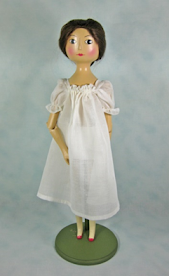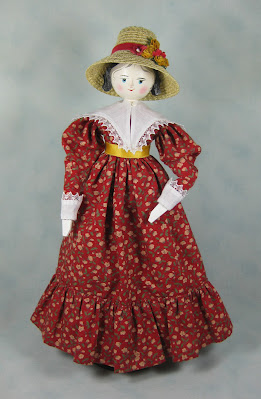Grödnertal
dolls are carved wood dolls originated from the Gardena Val, a valley in the
Dolomites of South Tyrol, now located in northern Italy. The area historical was claimed by several
countries, including Italy, Austria, and Germany. The area is known for its skilling, rock
climbing, and wood carving. It is the
wood carving that is of interest here.
The valley has a 400-year history of making peg wooden dolls, which were
turned on a lathe and also finished with hand carving.
The doll below is is a Grödnertal doll from Jonathan Green
& Company online. It isn’t the exact
doll that I bought from them, but is very close. (I didn’t have the heart or energy to strip
my doll naked to take a picture of her).
From the Jonathan Green website: “These replicas of the early 1900s “Penny
Wooden” dolls are made in the Grödner Tal region where the original dolls are
made. Each doll is turned and hand
painted by the artist Judith Sotriffer who carries on this 400 year old
tradition. Each doll is different. Variations in the wood and in the painting .
. . are part of the doll’s handmade charm. The 29cm/11.41 inch size is perfect
for sewing. In fact, she has her own set
of patterns available from Wish Booklets.” Judith Sotriffer’s website [https://shop.groednerpuppe.com]
indicates that the dolls are carved from cembra pine, which is native to the
Gardena Val.
In
2020, the French Fashion Doll Sewing Club online group had a challenge to make
an outfit for their doll representing an outfit from a movie or novel set in
from 1755 to 1920. The instructions were
simply to “select a favorite movie, TV program, or novel for your inspiration”
in dressing your doll. When I saw the
notice for the Cinema/Novel Event, I thought that the dresses that I was making
for Abigail were very much like the costumes worn by the lovely ladies, young
and old, in the mini-series, Cranford, set in rural England in the
early 1840’s. So I created photos of the
dresses I had made as my entry in the challenge.
To
begin, I took a screenshot of the opening credits to the first season of Cranford, pausing the video at a point
in between the written opening credits. Then,
using Photoshop, I superimposed a photo of my doll wearing
one of several costumes that I had made.
In each photo, Abigail is posed as one of the female characters, dressed
as that character would have been in the mini-series, Cranford.
The
first photo below shows Abigail dressed as Miss Mattie in her younger
days. The dress is adapted from the
morning dress pattern in Susan Sirkis’ Wardrobe
for a Wooden Doll. The bodice has a
natural neckline, with long full sleeves that are gathered with shirring at the
upper arm and into cuffs at the wrist.
The long full skirt is attached to a high waistline. Abigail wears a separate white collar which
has pointed Val lace around its outer edge.
The
next photo is Abigail as Mary Smith, who is visiting Miss Mattie. The dress is made from striped cotton that I
bought from Gail Wilson’s website back when she had a ton of fabric for
sale. I cut the fabric for the bodice on
the bias, so that the stripes form a V pattern.
The full skirt is attached to a bodice high waistline. The long full sleeves are gathered at the
upper arm by shirring and end at narrow cuffs.
Abigail wears a brown straw bonnet with a white ribbon hat band decorated
by brown and white pheasant feathers.

Abigail is shown here wearing the same
dress as above, but this time without the bonnet but with a white batiste
apron. It is gathered to a band at the
top, to which are attached two white satin ribbon apron strings. The two sides and bottom of the apron are
embellished with ½” Val lace.

Here
below Abigail represents Larentia Galindo, the milliner. This outfit was adapted from the cover outfit
on the Wishbooklet 1820-1825, by
Susan Sirkis. The white cotton batiste
blouse has a high band collar and vertical tucks on the bodice front. The long full sleeves end in simple
cuffs. There is a narrow black silk
ribbon bow at the center front neckline.
The skirt is made of tan, gray and black plaid fabric with a double
ruffle around the bottom. The top of the
upper ruffle is bordered with a narrow black silk ribbon band. The hat is a cream colored straw embellish
with a black ribbon hat band and black trim border around the outer edge. White feathers completed the embellishment.

In
this shot Abigail is playing Sophie Hutton wearing “the dress for a vicarage
bride.” This dress is adapted from
pattern 21 of Susan Sirkis’ Wishbooklet 1831-1835. The lined bodice and sleeves are made from
white voile. The bodice has a low
scooped neckline, with several horizontal pleats across the upper bodice. The sleeves are short and very puffed. The skirt is made from a length of Swiss
embroidery, with an overall pattern of lilies of the valley and a lower edge of
scalloped embroidery.
And
finally, here Abigail plays Jessie Brown wearing mourning clothes after the
death of her sister. This dress is made
of black batiste. There are vertical
tucks on the bodice. The plain neckline
is embellished with gathers of white Val lace.
The full gathered sleeves are also embellished with the same lace at the
cuffs. Abigail wears a black straw
bonnet decorated with a plain dove gray silk satin ribbon hat band, and with
ties of the same ribbon.

The
following dresses are ones that I made for Abigail but that were not part of my
Cranford challenge entry. This first one is a simple dress based on the morning
dress in Wardrobe for a Wood Doll. The bodice has been modified to have a
natural neckline. The sleeves are leg of
muttons, with upper arm fullness and lower arm narrower. There is no cuff. The full skirt is gather to a high
waistline. The dress is tan colored
cotton printed with widely scattered sprigs. Abigail wears the brown straw hat
that is decorated with a white ribbon hat band and pheasant feathers.

This
red cotton dress is modeled on an 1830’s dress found on the Internet. It is adapted from the morning dress pattern
of Susan Sirkis’ Wardrobe for a Wood
Doll. Gold soutache forms a scroll
pattern around the upper bodice and around the lower sleeves. The same gold soutache forms a double zig zag
pattern around the lower skirt. There is
a red fabric belt with an antique gold colored buckle at the waist. Abigail is wearing a natural straw hat with a
red hatband. It is decorated by gold
roses and red petal flowers. She wears
the red decorated hat with this red and yellow dress, as well as with the two
red and yellow dresses that follow.

The
next dress began with the pattern for the morning dress in Susan Sirkis’ Wardrobe for a Wood Doll. It is made from red calico with greenery and
yellow flowers. The dress has leg of
mutton sleeves, in which the upper arm is covered by a large puffed sleeve,
while the sleeve narrows considerably over the lower arm. I added cuffs contoured to fit the lower
sleeve, with an edging of Val lace that has a pointed outer edge, rather than
scallops. I made the waistline of the
bodice fit at the natural waist, and added a pelerine of white batiste, with
the same lace used on the cuffs used around the edge of the pelerine. The pelerine closes at the neck with a single
white button and a thread loop on the other side. The full skirt is gathered at the high waist,
and has a 2½” ruffle at the lower edge.
The dress has a waistband of golden yellow silk ribbon.
This
dress is made from pink-on-pink sprigged cotton. The pink is a shade of dusty old rose. The
bodice is made from the day dress pattern in Susan Sirkis’ Wardrobe for a Wood Doll. It
has a narrow self binding around the scooped neckline. The sleeves are short puffed sleeves. To gather the fullness of the sleeves,
cartridge gathers are used at the cuffs.
The full gathered skirt is attached to the high waistline of the bodice
and the skirt has a full gathered ruffle at the lower edge. There is a
dyed-to-match pink silk satin sash around the waistline that ties in a bow at
the back.
This
is the pièce de resistance of Abigail’s wardrobe. It is a pink silk taffeta ball gown The bodice has very full puffed sleeves with
narrow cuffs of the pink silk. There is
a broad V collar with 1¼” val lace attached at the lower edge. The lace was cut so that the full 1¼” width
is attached at the top of each shoulder, and then the lace tapers down to
nothing at the center front and center back. There is a gathered ruffle of the
same lace at the lower edge of the dress.
The skirt is gathered with cartridge pleats attached to the high bodice
waistline.
I
wanted to make just a simple nightgown, so I started with pattern 8 from Susan
Sirkis’ Wishbooklet 1853-1858. I made the center placket considerably
longer, to make it easier to get on and off the doll. The nightgown has a high yoke, to which the
slightly gathered skirt is attached. The
center placket is edged with ¼” Val lace. I eliminated the little collar used
in the pattern and just used the same Val lace gathered around the neckline. The sleeves are long and full, ending in cuffs
to which there is also Val lace gathered.
The center placket closes with eight ⅛” white buttons and tiny handmade
buttonholes. I agonized in making those
buttonholes!
Abigail
is wearing a wrapper here for which pattern 12 from Susan Sirkis’ Wishbooklet 1931-1935 was used. It is
made of white cotton batiste. It has a
fitted bodice with a V-shaped yoke delineated by a ruffle of ¾” Val lace. There is a small white collar edged with ¼”
Val lace. The skirt is gathered. The sleeves are long and fully gathered,
ending in cuffs edged with ¼” lace.
There is a small white silk bow at the neckline and a larger one with
streamers at the waist. The wrapper
closes with hooks and eyes down the front.
The
final photo shows Abigail in her pantaloons and petticoat. Both pieces are made of white cotton
batiste. There are three tucks around
the bottom of the petticoat, with a ⅝” band of Swiss embroidery. The bottom of each leg of the pantaloons also
has three tucks and a band of the same Swiss embroidery.





























